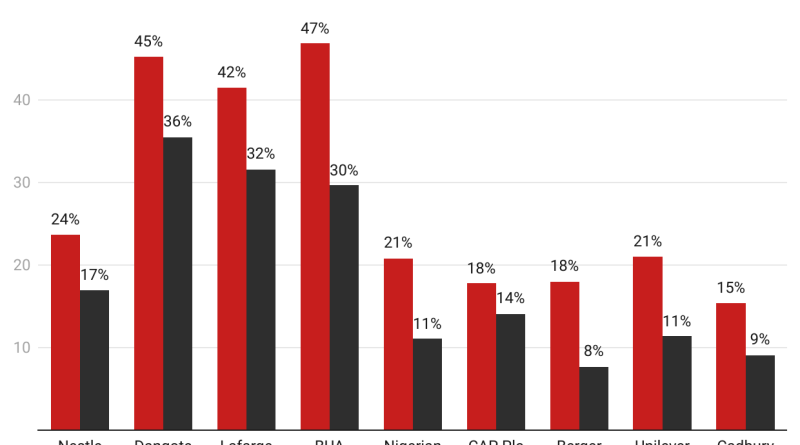How Nigeria’s manufacturers are eating the fruit of inflation
In 2025, Nigeria’s manufacturers are reaping the fruits of inflation. Profits are swelling, not because factories are producing more, but because they’re charging more.
When profit margins outpace the cost of sales, it usually signals one thing: prices have risen. And for many Nigerian manufacturers, that is the defining story of 2025.
A BusinessDay review of nine-month financial statements from selected listed companies reveals a clear pattern. Firms across both the consumer and industrial goods sectors have leveraged inflation to lift their prices, and, by extension, their revenues.
But this growth is driven more by pricing than productivity. Manufacturers are earning more not by selling greater volumes, but by selling the same goods at higher prices.
Take Nestlé Nigeria, for example. The company reported a 33 percent year-over-year increase in revenue for the nine months ended September 2025. Over the same period, its cost of sales rose by just 22 percent, resulting in a 58 percent increase in gross profit. Nestlé’s gross margin climbed to 37 percent in 9M 2025, up from 31 percent a year earlier.
Nestlé is not an isolated case. This pattern of rising revenues without a proportional spike in costs runs across the board.
Read Also: Manufacturing sees modest growth in second quarter amid challenges – Businessday NG
EBITDA margins tell a bigger story
Ordinarily, companies might justify higher prices as a response to rising operational expenses. But their EBITDA margins tell a different story. Nestlé’s EBITDA margin rose to 23.7 percent in 9M 2025, about 6.7 percentage points higher than the 17 percent recorded a year earlier.
The cement majors, Dangote, BUA, and Lafarge, show the same inflation-driven profitability. Their average EBITDA margins climbed to 44.5 percent in 9M 2025, up 12.2 percentage points from 32.3 percent in 2024. Isolating only their Nigerian operations, the combined average margin jumps even higher, to 49.2 percent, making them some of the biggest beneficiaries of Nigeria’s inflationary surge.
Although inflation has declined sharply in 2025, from around 30 percent in 2024 to 18.02 percent as of September 2025, manufacturers have still found room to raise prices aggressively. Some observers argue that, when adjusted for inflation, these gains are less impressive than they appear.
However, data from some manufacturers show that prices have not only kept pace with costs, they have also outpaced them.
Using the average inflation rate of 22.2 percent recorded in the first nine months of 2025, the real margins tracked by BusinessDay have risen significantly. Nestlé’s real EBITDA margin in 9M 2025, for example, stands at 19.4 percent, compared with 12.8 percent in 2024 after adjusting for inflation.
It is widely understood that when prices rise faster than costs, a company’s margins improve.
Cement and beer are big winners
For cement makers, this effect is particularly pronounced. Dangote Cement’s gross margin, after factoring inflation, was 48.5 percent, almost 10 percentage points higher than the 39 percent recorded in 2024. Lafarge Africa’s real gross margin reached 47.8 percent, about 10 percentage points higher than the 37 percent recorded a year earlier. BUA Cement’s gross margin, post-inflation adjustment, stood at 41 percent.
The beer makers tell a similar story. Nigerian Breweries posted a gross margin of 40 percent in 9M 2025, up from 29.5 percent in the same period of 2024. After adjusting for inflation, its gross margin was 32.6 percent. With additional cost-cutting measures, the group’s operating margin jumped to 15.8 percent, from 3.8 percent in 9M 2024.
Read Also: BUA Cement profit rises 6-fold on FX gains – Businessday NG
Yet, not all sectors enjoy such pricing power. In more competitive markets, firms face limits in raising prices. Unilever’s gross margin, for example, remained steady at 41 percent between 9M 2024 and 9M 2025. Operational improvements, however, helped boost its operating margin to 20 percent, from 10 percent a year earlier.
Cadbury experienced modest gains. Its gross margin rose to 23.3 percent in 9M 2025, from 16.5 percent in 9M 2024, growth, but not at the same pace as other manufacturers.
Muda Yusuf, CEO of the Centre for Promotion of Private Enterprises, explains why: “Pricing power differs across sectors depending on demand elasticity. Firms in highly competitive consumer markets can’t easily raise prices without losing customers, and this compresses their margins.”
He adds, “But in sectors like cement, where demand is less elastic, companies can push prices up more easily.”

